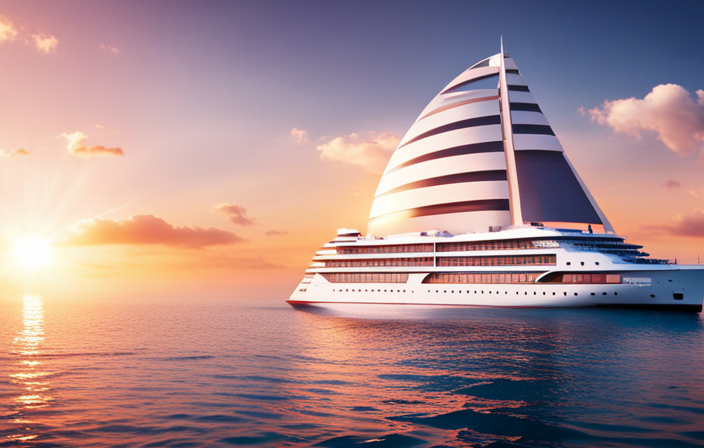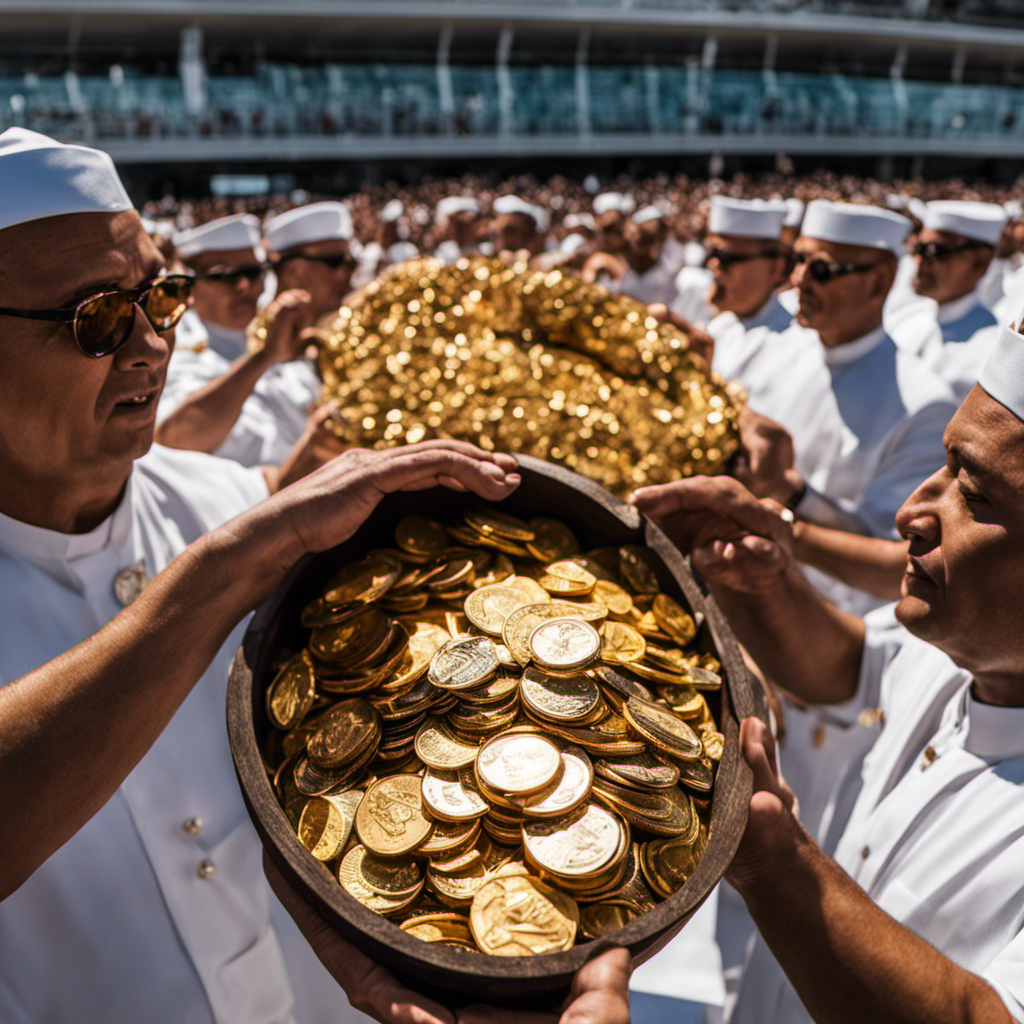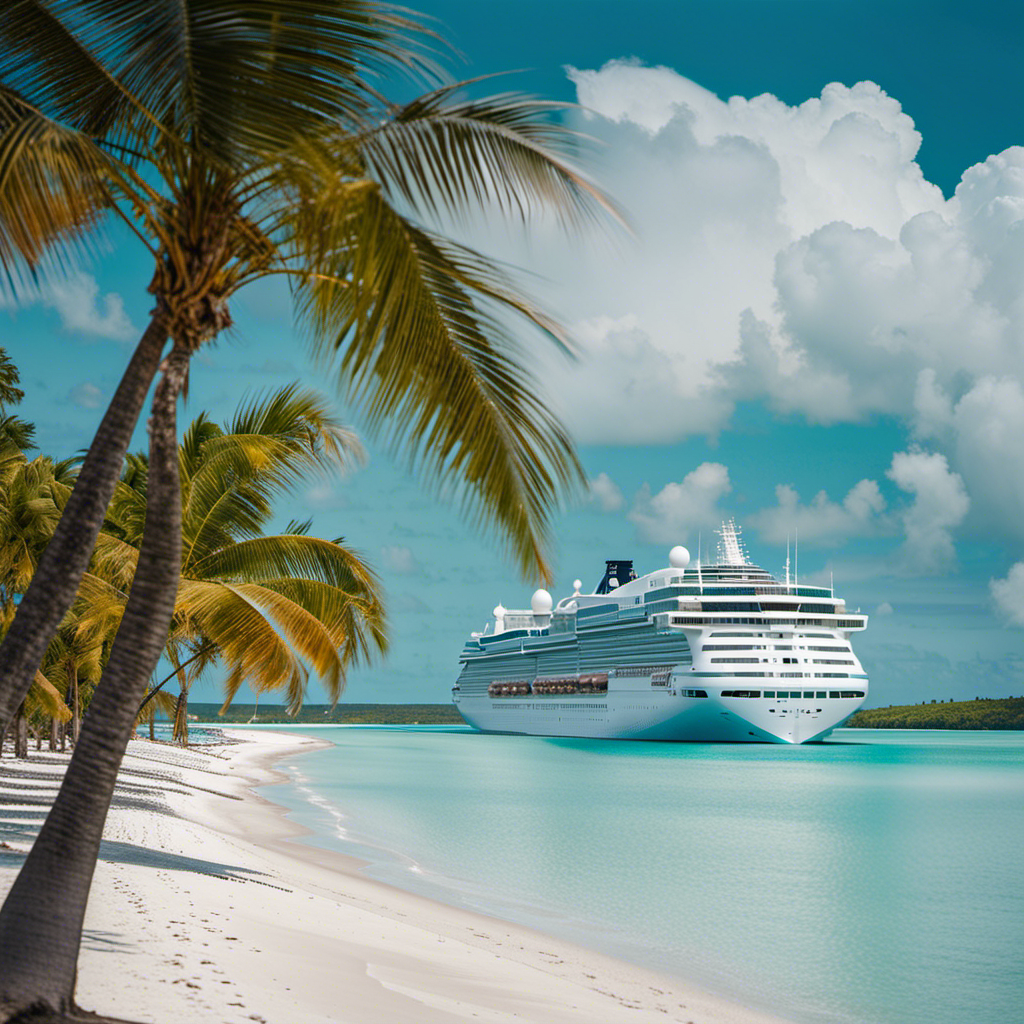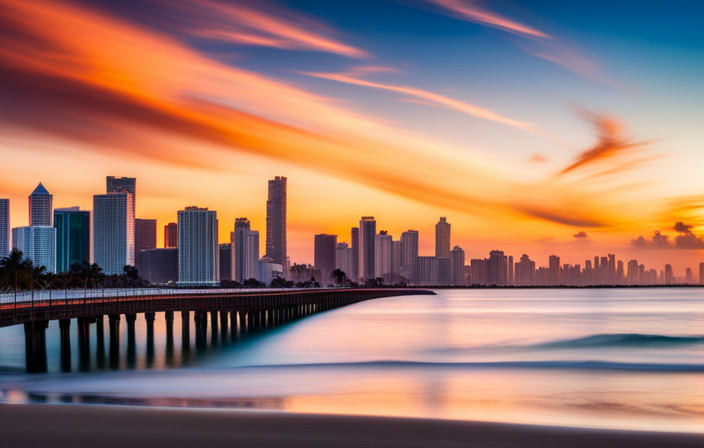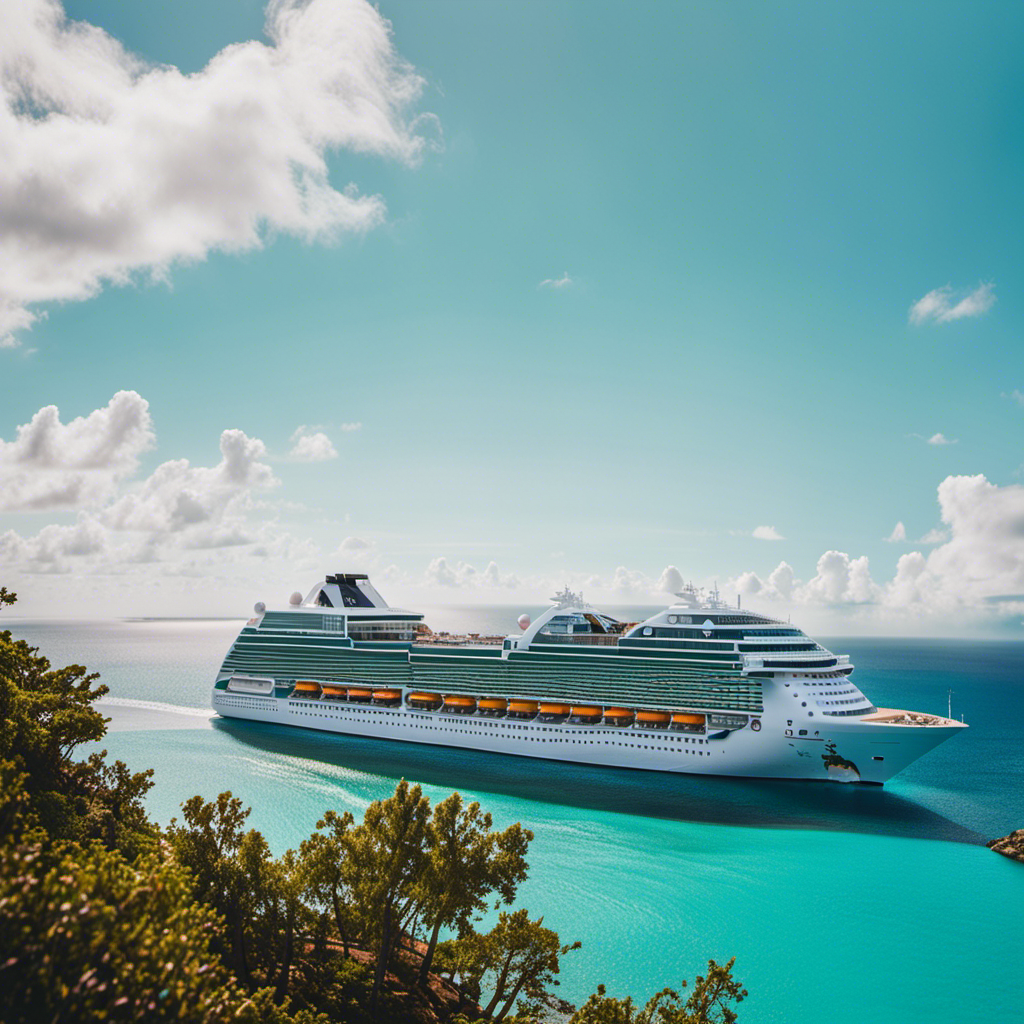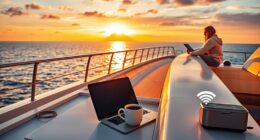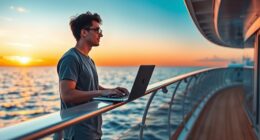When I stepped onto the Viking Grace, I was immediately impressed by the sophisticated rotor sails adorning the vessel’s sleek exterior. These state-of-the-art innovations, developed by Norsepower Oy Ltd, are transforming maritime travel.
By harnessing the power of the Magnus effect, the rotor sails propel the ship forward, reducing CO2 emissions by a staggering 900 tons annually. Viking Line’s dedication to eco-friendly travel is evident as they continue to pioneer innovative solutions for greener seas.
Join me as we embark on a journey towards a more sustainable future.
Key Takeaways
- Viking Grace is the first passenger ship to use a high-tech rotor sail, developed by Norsepower, which reduces CO2 emissions by 900 tons per year.
- Viking Line, the Baltic company, is known for its eco-friendly travel and has been using low-emission Liquefied Natural Gas (LNG) since 2013.
- The rotor sail operates based on the Magnus effect, creating a difference in air pressure to propel the ship forward, similar to the backspin on a golf ball.
- Viking Line’s commitment to eco-friendly travel is demonstrated by the future plans to install two similar rotor sails on their newest ship, doubling its power output and reducing fuel consumption.
The First Passenger Ship to Use Rotor Sail Technology
I’m amazed to learn that Viking Grace is the first passenger ship to use the high-tech rotor sail technology. The implementation of this innovative solution has had a significant impact on the passenger experience.
The rotor sail, a cylindrical device that propels the ship by spinning, has reduced CO2 emissions by 900 tons per year. However, the adoption of rotor sail technology has not been without its challenges.
The installation and integration of the rotor sail system required careful planning and engineering expertise. Additionally, ensuring the safe and efficient operation of the rotor sail technology has required ongoing monitoring and maintenance.
Despite these challenges, Viking Grace has successfully implemented rotor sail technology, showcasing their commitment to eco-friendly travel and their dedication to providing passengers with a sustainable and enjoyable experience.
How Rotor Sails Reduce CO2 Emissions
The use of rotor sail technology significantly decreases the amount of CO2 emissions released into the environment. Rotor sails offer several advantages in reducing air pollution.
Firstly, they utilize the power of wind to propel the ship, reducing the reliance on fossil fuels. This results in a significant decrease in CO2 emissions, as well as other harmful pollutants such as sulfur oxides.
Secondly, rotor sails are a highly efficient and cost-effective solution. They can be easily integrated into existing ships, requiring minimal modifications. Additionally, rotor sails operate silently, without producing any noise pollution. This makes them an ideal solution for environmentally conscious shipping companies.
Overall, the impact of rotor sails on air pollution is substantial, offering a greener and more sustainable future for the maritime industry.
The Eco-Friendly Reputation of Viking Grace
Viking Line’s commitment to eco-friendly travel is well-known in the industry. Here are the benefits of Liquefied Natural Gas (LNG) as a fuel for Viking Grace:
- Liquefied Natural Gas (LNG) Benefits:
- LNG is a cleaner fuel compared to traditional marine fuels, reducing sulfur oxide (SOx) emissions by 99% and nitrogen oxide (NOx) emissions by 85%.
- LNG also reduces particulate matter (PM) emissions and eliminates the need for heavy fuel oil.
These benefits of LNG have a direct impact on the passenger experience:
- Impact on Passenger Experience:
- Reduced emissions mean cleaner air quality onboard, creating a healthier environment for passengers and crew.
- The use of LNG also reduces noise pollution, providing a quieter and more comfortable voyage.
- Viking Line’s eco-friendly practices demonstrate their commitment to sustainable travel, enhancing the overall passenger experience.
Viking Line’s dedication to eco-friendly travel and the use of LNG on Viking Grace benefits both the environment and passenger well-being.
Rotor Sail Implementation in Viking Line’s Newest Ship
Developed by Norsepower Oy Ltd, the implementation of rotor sail technology on Viking Line’s newest ship is a significant step towards more sustainable and fuel-efficient travel. Rotor sails are cylindrical devices that harness the power of the wind to propel the ship forward.
This innovative technology reduces fuel consumption and lowers emissions, contributing to a greener maritime industry. The efficiency of rotor sails lies in their ability to utilize the Magnus effect, which creates a pressure difference and generates thrust. By harnessing the power of the wind, rotor sails can significantly reduce the environmental impact of shipping.
With the installation of rotor sails on Viking Line’s newest ship, the company is showcasing its commitment to sustainable practices and leading the way towards a more eco-friendly future for the maritime industry.
The Principle Behind Rotor Sail Propulsion
Using the Magnus effect, the spinning rotor sail creates a difference in air pressure to move the ship forward. This innovative technology, developed by Norsepower Oy Ltd, revolutionizes ship propulsion.
The rotor sail harnesses the power of the Magnus effect, where air flows with lower pressure on one side than the other. This creates a force that propels the ship in the desired direction.
The development of rotor sail technology by Norsepower Oy Ltd has paved the way for a more sustainable and efficient mode of transportation. By utilizing the Magnus effect, the rotor sail reduces the ship’s reliance on traditional fuel sources, leading to a significant decrease in CO2 emissions.
This groundbreaking technology marks a major step forward in the maritime industry’s efforts to reduce its environmental impact.
The Effectiveness of the Magnus Effect
In addition to propelling ships like the Viking Grace, the Magnus effect has also been applied in other applications. For example, it has been used in sports equipment, such as tennis rackets and golf balls, to enhance their performance. The effect has also been studied in wind turbines, where it can potentially increase their efficiency by generating more power.
However, it is important to note that there are potential limitations to rotor sail technology. One limitation is the dependence on wind conditions. Rotor sails are most effective when there is a consistent and favorable wind direction. In areas with unpredictable or weak winds, the effectiveness of rotor sails may be limited.
Another limitation is the added weight and complexity that rotor sails introduce to a ship’s design. Retrofitting existing ships with rotor sails can be challenging and may require significant modifications to the ship’s structure.
Despite these limitations, the implementation of rotor sails in the shipping industry holds great promise for reducing fuel consumption and CO2 emissions. Ongoing research and development in this field will likely lead to further advancements and improvements in the effectiveness of rotor sail technology.
Future Plans for Rotor Sail Expansion
As a pioneer in eco-friendly travel, Viking Line has ambitious plans to expand the implementation of rotor sail technology. The efficiency of rotor sails and the economic benefits they offer make them a compelling choice for sustainable shipping.
Here are four reasons why Viking Line is investing in rotor sail expansion:
-
Increased fuel efficiency: Rotor sails harness wind power to propel the ship, reducing the reliance on traditional fuel sources. This results in significant fuel savings and a lower carbon footprint.
-
Cost savings: By reducing fuel consumption, rotor sails can lead to substantial cost savings for shipping companies. This makes them an attractive option from an economic standpoint.
-
Environmental impact: Rotor sails help reduce greenhouse gas emissions, contributing to cleaner air and a healthier environment. This aligns with Viking Line’s commitment to reducing the environmental load and promoting the well-being of the sea.
-
Innovation and leadership: By expanding the use of rotor sails, Viking Line continues to lead the way in sustainable shipping practices. The company’s dedication to finding innovative solutions that reduce fuel consumption sets an example for the industry.
Viking Line’s Pride in Rotor Sail Innovation
I’m proud to be part of the team that developed the innovative rotor sail technology for Viking Line’s passenger ship. Viking Line’s commitment to sustainability is evident through the implementation of this groundbreaking technology.
The impact of rotor sail technology on the shipping industry cannot be overstated. By harnessing the power of the wind through the Magnus effect, the rotor sail reduces CO2 emissions by 900 tons per year, making it a game-changer in the quest for greener seas.
This technology aligns with Viking Line’s mission to promote the well-being of the sea and showcases their dedication to sustainable shipping practices. The rotor sail’s success has generated interest and excitement within the industry, paving the way for future innovations in propulsion systems and revolutionizing the way we navigate the world’s oceans.
The Innovative and World-Class Rotor Sail Technology
Developed by Norsepower Oy Ltd, the rotor sail technology on Viking Grace’s passenger ship showcases an innovative and world-class solution for reducing fuel consumption and promoting sustainable shipping practices.
The benefits of rotor sail technology in the maritime industry are significant. By harnessing the power of the wind, rotor sails can provide additional propulsion, reducing the reliance on fossil fuels and decreasing CO2 emissions. This technology has the potential to revolutionize the shipping industry by making vessels more energy-efficient and environmentally friendly.
Furthermore, the potential applications of rotor sail technology in other types of ships are vast. From cargo vessels to ferries, rotor sails can be implemented to optimize fuel efficiency and reduce operating costs.
The success of Viking Grace’s rotor sail technology paves the way for a greener and more sustainable future in maritime transportation.
The Significant Reduction in Fuel Consumption
The significant reduction in fuel consumption is one of the key advantages of implementing rotor sail technology on Viking Grace’s passenger ship. This innovative solution has the potential to revolutionize the maritime industry with its cost effectiveness and the potential impact it can have on other industries.
Here are three important points to consider:
-
The rotor sail technology reduces CO2 emissions by 900 tons per year, making it an environmentally friendly option.
-
By harnessing the power of the Magnus effect, the rotor sail propels the ship forward, minimizing the need for traditional fuel consumption.
-
The implementation of rotor sails on Viking Grace showcases the potential for this technology to be applied to other industries, such as cargo shipping and even renewable energy generation.
Overall, the significant reduction in fuel consumption achieved through rotor sail technology is a game-changer, offering a greener and more sustainable future for the maritime industry and beyond.
Viking Line’s Dedication to Sustainable Shipping Practices
As someone who is passionate about protecting the environment, it is inspiring to see Viking Line’s dedication to sustainable shipping practices.
Viking Line has made a strong commitment to the environment by implementing various measures to reduce their environmental impact. One of their key efforts is the use of rotor sail technology on their ships. The rotor sail is a cylindrical device that spins and propels the ship forward using the Magnus effect. This innovative solution has been developed by Norsepower Oy Ltd and has proven to be highly effective in reducing fuel consumption and CO2 emissions.
Viking Line’s commitment to the environment is further demonstrated by their use of low-emission Liquefied Natural Gas (LNG) as fuel. Their efforts in sustainable shipping practices showcase their dedication to protecting the environment and promoting a greener future in the shipping industry.
Frequently Asked Questions
How Does the Rotor Sail Technology Work?
The rotor sail technology works by utilizing the Magnus effect. The spinning cylinder creates a pressure difference, propelling the ship forward. This innovative solution offers advantages such as reduced fuel consumption and lower environmental impact.
What Are the Benefits of Using Rotor Sails on Viking Grace?
Using rotor sails on Viking Grace provides multiple benefits, such as reduced fuel consumption and lower emissions. The innovative technology developed by Norsepower helps propel the ship forward, aligning with Viking Line’s commitment to eco-friendly travel.
How Does Viking Line Plan to Expand the Use of Rotor Sails in the Future?
Viking Line plans to expand the use of rotor sails by installing two similar ones on their newest ship. These future rotor sail projects will double the power output, further demonstrating their commitment to eco-friendly travel.
What Other Eco-Friendly Initiatives Has Viking Line Implemented Besides Rotor Sails?
Besides rotor sails, Viking Line has implemented several eco-friendly initiatives and sustainability measures. These include using low-emission Liquefied Natural Gas (LNG) since 2013, reducing fuel consumption, and promoting the well-being of the sea.
How Does the Rotor Sail Technology Align With Viking Line’s Mission of Promoting the Well-Being of the Sea?
The rotor sail technology aligns with Viking Line’s mission of promoting the well-being of the sea by reducing carbon emissions in the shipping industry. It showcases our commitment to sustainable shipping practices and the positive impact of rotor sails.
Conclusion
In conclusion, Viking Grace’s utilization of rotor sail technology marks a significant milestone in the shipping industry’s transition towards greener practices.
With the rotor sail’s ability to harness the Magnus effect, Viking Grace has successfully reduced its CO2 emissions by an impressive 900 tons per year.
This groundbreaking innovation, coupled with Viking Line’s commitment to eco-friendly travel, showcases their dedication to sustainable shipping practices.
As Viking Line plans to install similar sails on their new ship, the question arises: Will rotor sail technology become the norm, revolutionizing the way ships navigate our oceans?

